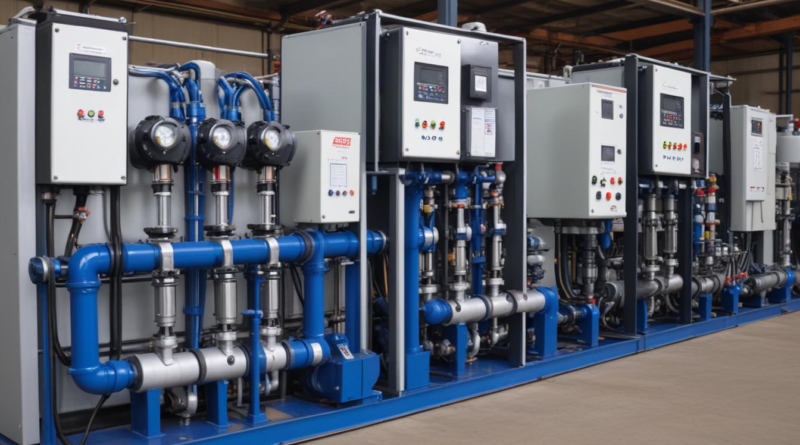automated pump control systems
Automated pump control systems play a crucial role in various industries by ensuring the efficient and reliable operation of pumping equipment. These control systems leverage advanced technology to monitor and manage pump functions, reducing the need for manual intervention and minimizing the risk of human error. By integrating sensors, controllers, and actuators, automated pump control systems can adjust flow rates, pressures, and operational schedules in real-time based on demand and environmental conditions.
The primary objectives of pump automation include enhancing energy efficiency, extending the lifespan of pump machinery, and maintaining optimal performance levels. By continuously analyzing data from multiple sources, these systems can detect anomalies, predict maintenance needs, and optimize operational parameters to achieve cost savings and improve overall system reliability.
Key advantages of automated pump control systems include:
- Increased Efficiency: Automated adjustments ensure pumps operate at optimal performance, reducing energy consumption and operational costs.
- Enhanced Reliability: Continuous monitoring and predictive maintenance capabilities minimize downtime and extend equipment lifespan.
- Improved Safety: Automated shut-off features and real-time alerts help prevent accidents and equipment damage.
- Scalability: These systems can be easily scaled to accommodate growing operational demands or integrate with other automation technologies.
Modern automated pump control systems often incorporate various technologies such as:
| Technology | Description |
|---|---|
| Programmable Logic Controllers (PLCs) | Widely used for their versatility in controlling complex pump operations through programmable instructions. |
| Variable Frequency Drives (VFDs) | Adjust the speed of pump motors to match the required flow rates, enhancing energy efficiency. |
| Wireless Sensors | Enable remote monitoring and data collection, facilitating real-time analysis and decision-making. |
| Industrial Internet of Things (IIoT) | Integrates pump systems with broader industrial networks for enhanced data analytics and interoperability. |
In summary, automated pump control systems represent a significant advancement in pump management, offering substantial benefits in terms of efficiency, reliability, and operational flexibility. As technology continues to evolve, these systems are becoming increasingly sophisticated, enabling more precise control and integration with other automated processes across various sectors.
key components and technologies
A critical aspect of effective pump automation lies in the seamless integration of its fundamental components. These elements work in unison to ensure precise control, optimal performance, and adaptability to varying operational demands. Below are the essential components that constitute an automated pump control system:
- Controllers: The brain of the system, controllers process input from sensors and execute predefined algorithms to manage pump operations. They can range from simple microcontrollers to sophisticated Programmable Logic Controllers (PLCs) equipped with advanced processing capabilities.
- Sensors: These devices monitor critical parameters such as pressure, flow rate, temperature, and vibration. Accurate sensor data is vital for real-time decision-making and maintaining system stability.
- Actuators: Responsible for executing commands from the controller, actuators adjust valves, switches, and motor speeds to regulate the pump’s operation based on the controller’s directives.
- Human-Machine Interfaces (HMIs): HMIs provide operators with visual representations of the pump system’s status and allow for manual adjustments when necessary. They enhance user interaction and facilitate easier system monitoring.
- Communication Interfaces: These interfaces enable data exchange between the pump control system and other industrial networks or devices. Common protocols include Modbus, Ethernet/IP, and Profibus, which support interoperability and integration with broader automation systems.
- Power Supplies: Reliable power sources are essential to maintain uninterrupted operation of the control system components. They ensure that controllers, sensors, and actuators receive consistent voltage levels, safeguarding against power fluctuations.
In addition to these components, several advanced technologies enhance the functionality and efficiency of automated pump control systems:
| Advanced Technology | Functionality |
|---|---|
| Artificial Intelligence (AI) and Machine Learning | Enable predictive maintenance by analyzing patterns and forecasting potential failures, thereby reducing downtime and maintenance costs. |
| Edge Computing | Processes data locally at the pump site, reducing latency and improving real-time response capabilities. |
| Cloud Integration | Facilitates remote monitoring and control, data storage, and advanced analytics through centralized cloud platforms. |
| Cybersecurity Measures | Protect the control system from unauthorized access and cyber threats, ensuring data integrity and system reliability. |
The integration of these components and technologies results in a highly responsive and adaptable pump control system. By leveraging pump automation, industries can achieve superior operational efficiency, enhanced system reliability, and the ability to swiftly adapt to changing conditions. Furthermore, the incorporation of emerging technologies like AI and IIoT positions automated pump control systems at the forefront of industrial innovation, paving the way for smarter and more resilient infrastructure.
Advanced diagnostics tools also play a pivotal role in modern pump control systems. These tools provide detailed insights into system performance, enabling operators to identify and address issues proactively. Features such as real-time data visualization, trend analysis, and automated reporting streamline maintenance processes and support informed decision-making.
Additionally, energy management technologies are increasingly becoming integral to pump automation. By optimizing energy consumption through precise control of motor speeds and operational schedules, these technologies contribute to significant cost savings and promote sustainable practices. Energy-efficient control systems not only reduce operational expenses but also align with environmental regulations and corporate sustainability goals.
In conclusion, the synergy between robust components and cutting-edge technologies underpins the effectiveness of automated pump control systems. As industries continue to evolve, these systems will undoubtedly incorporate more sophisticated features, driving further advancements in pump automation and operational excellence.
installation and configuration
Proper installation and configuration are critical to the successful deployment of automated pump control systems. Ensuring that each component is correctly set up and integrated allows the system to operate efficiently and reliably. The following outlines the key steps and best practices involved in this process:
- Site Assessment: Conduct a thorough evaluation of the installation site to identify environmental factors, space constraints, and existing infrastructure. This assessment helps determine the optimal placement of controllers, sensors, and actuators, as well as the necessary power and network requirements.
- System Design: Develop a comprehensive design plan that outlines the layout of the control system components. This includes selecting appropriate equipment, defining communication protocols, and ensuring compatibility with existing systems. Utilizing pump automation design software can facilitate accurate planning and simulation.
- Hardware Installation:
- Mounting Controllers and HMIs: Securely install the central controllers and Human-Machine Interfaces (HMIs) in accessible locations. Ensure that these devices are protected from environmental hazards such as moisture, dust, and extreme temperatures.
- Sensor Placement: Position sensors at critical points within the pump system to accurately monitor parameters like pressure, flow rate, and temperature. Proper calibration of sensors during installation is essential for reliable data collection.
- Actuator Integration: Connect actuators to valves, switches, and other mechanical components to enable precise control based on system commands. Verify that actuators operate smoothly and respond correctly to control signals.
- Power Supply Setup: Ensure that all control system components receive stable and appropriate power. Implement backup power solutions, such as uninterruptible power supplies (UPS), to maintain system functionality during power outages.
- Electrical and Networking Connections:
- Establish reliable electrical connections between controllers, sensors, and actuators, adhering to electrical codes and safety standards.
- Set up network infrastructure to facilitate communication between system components. This may involve configuring wired or wireless connections, depending on the site’s requirements and the chosen communication protocols.
- Implement cybersecurity measures to protect the control system from unauthorized access and cyber threats. This includes using firewalls, encryption, and secure authentication methods.
- Software Installation and Configuration:
- Install the necessary software on controllers and HMIs, including firmware updates and control algorithms tailored to the specific pump applications.
- Configure the software settings to match the system design specifications. This involves setting up control parameters, establishing communication protocols, and defining alarm thresholds.
- Integrate the control system with existing industrial automation platforms, ensuring seamless data exchange and interoperability with other equipment and systems.
- System Testing and Validation:
- Perform comprehensive testing of the entire control system to verify that all components operate correctly and interact as intended. This includes functional tests, communication tests, and performance evaluations.
- Simulate various operating conditions to assess the system’s responsiveness and reliability. Identify and address any issues or discrepancies that arise during testing.
- Validate that the control algorithms effectively manage pump operations, maintaining desired flow rates, pressures, and energy consumption levels.
- Operator Training and Documentation:
- Provide training for operators and maintenance personnel on the operation and troubleshooting of the automated pump control system. Ensure they are familiar with the Human-Machine Interfaces (HMIs) and understand the system’s functionalities.
- Develop comprehensive documentation, including installation manuals, configuration guides, and maintenance procedures. This documentation serves as a valuable reference for ongoing system management and future upgrades.
Adhering to these installation and configuration practices ensures that automated pump control systems function optimally from the outset. Proper setup not only maximizes the benefits of pump automation but also lays the foundation for long-term reliability and efficiency. By following a structured approach and utilizing best practices, organizations can achieve seamless integration of their control systems into existing operations, thereby enhancing overall performance and reducing the risk of operational disruptions.
maintenance and troubleshooting
 Regular maintenance is essential to ensure the longevity and optimal performance of automated pump control systems. Implementing a structured maintenance program not only minimizes downtime but also prevents costly repairs and extends the lifecycle of both the pumps and their associated control technologies. Effective maintenance strategies encompass both routine inspections and proactive troubleshooting measures.
Regular maintenance is essential to ensure the longevity and optimal performance of automated pump control systems. Implementing a structured maintenance program not only minimizes downtime but also prevents costly repairs and extends the lifecycle of both the pumps and their associated control technologies. Effective maintenance strategies encompass both routine inspections and proactive troubleshooting measures.
- Scheduled Inspections: Regularly scheduled inspections help identify potential issues before they escalate. Key areas to examine include:
- Sensors and Actuators: Ensure all sensors are calibrated correctly and actuators are functioning smoothly. Replace any components showing signs of wear or damage.
- Controllers and HMIs: Verify that controllers are operating within specified parameters and that Human-Machine Interfaces are displaying accurate information.
- Electrical Connections: Check for loose or corroded connections that could disrupt communication between system components.
- Preventive Maintenance: Implement preventive measures to reduce the likelihood of unexpected failures. This includes:
- Lubrication: Regularly lubricate moving parts to reduce friction and prevent overheating.
- Cleaning: Keep all components free from dust, debris, and other contaminants that could impede system performance.
- Firmware Updates: Update the control system’s firmware to incorporate the latest improvements and security patches.
- Predictive Maintenance: Utilize advanced technologies to anticipate maintenance needs based on real-time data analytics. Techniques include:
- Vibration Analysis: Monitor pump and motor vibrations to detect imbalances or misalignments.
- Thermography: Use thermal imaging to identify overheating components that may indicate electrical faults or mechanical stress.
- Performance Monitoring: Analyze flow rates, pressures, and energy consumption patterns to identify deviations from normal operating conditions.
Troubleshooting is a critical aspect of maintaining automated pump control systems. When issues arise, a systematic approach to problem-solving ensures efficient resolution and minimizes operational disruptions.
- Identify the Problem: Clearly define the issue by gathering information from system alerts, operator reports, and diagnostic tools. Determine whether the problem is related to hardware, software, or operational parameters.
- Isolate the Cause: Use diagnostic procedures to pinpoint the root cause. This may involve:
- Checking sensor readings for accuracy.
- Verifying communication between controllers and actuators.
- Inspecting electrical components for signs of damage or malfunction.
- Implement a Solution: Once the cause is identified, take corrective actions such as:
- Replacing faulty sensors or actuators.
- Updating or reprogramming control software.
- Repairing or tightening electrical connections.
- Test and Verify: After implementing the solution, conduct tests to ensure the system operates correctly. Monitor key performance indicators to confirm that the issue has been resolved.
- Document the Issue and Resolution: Maintain detailed records of problems encountered and the steps taken to address them. This documentation aids in future troubleshooting and enhances the overall maintenance strategy.
In addition to routine maintenance and troubleshooting, leveraging pump automation technologies can significantly enhance the efficiency of maintenance processes. Automated diagnostic tools and remote monitoring capabilities enable real-time data analysis, allowing maintenance teams to respond swiftly to emerging issues. Integrating these technologies with existing maintenance management systems facilitates streamlined workflows and improves overall maintenance effectiveness.
A well-maintained automated pump control system contributes to sustained operational efficiency, reduced energy consumption, and enhanced reliability. By prioritizing regular maintenance and adopting proactive troubleshooting practices, organizations can maximize the benefits of their pump automation investments and ensure seamless, uninterrupted operations.
future trends and advancements
The future of automated pump control systems is poised to be shaped by several emerging technologies and evolving industry trends. As industries continue to seek greater efficiency, reliability, and sustainability, advancements in pump automation will play a pivotal role in meeting these demands. Below are some of the key trends and innovations expected to influence the development of pump control systems in the coming years:
- Artificial Intelligence and Machine Learning:
- AI and machine learning algorithms will enhance predictive maintenance by analyzing vast amounts of operational data to identify patterns and predict potential failures before they occur.
- These technologies will enable more sophisticated decision-making processes, allowing control systems to optimize pump operations dynamically based on real-time conditions.
- Internet of Things (IoT) Integration:
- IoT-enabled sensors and devices will facilitate seamless communication between pump control systems and other industrial equipment, fostering a more interconnected and intelligent infrastructure.
- Enhanced data collection and connectivity will support advanced analytics, enabling organizations to gain deeper insights into their pump operations and make data-driven decisions.
- Edge Computing:
- Processing data closer to the source will reduce latency and improve the responsiveness of control systems, enabling real-time adjustments and more efficient operations.
- Edge computing will also enhance the reliability of pump automation by ensuring critical functions can continue even during network disruptions.
- Advanced Cybersecurity Measures:
- As pump control systems become more connected, safeguarding against cyber threats will be paramount. Future systems will incorporate advanced security protocols, encryption techniques, and intrusion detection mechanisms to protect sensitive data and ensure system integrity.
- Proactive cybersecurity strategies will be essential to prevent unauthorized access and mitigate potential vulnerabilities in automated pump control systems.
- Energy Efficiency and Sustainability:
- Innovations in energy management technologies will enable pump automation systems to optimize energy consumption, reducing operational costs and minimizing environmental impact.
- Integration with renewable energy sources and smart grid technologies will further enhance the sustainability of pump operations.
- Enhanced Human-Machine Interfaces (HMIs):
- Future HMIs will offer more intuitive and user-friendly interfaces, incorporating augmented reality (AR) and virtual reality (VR) to provide immersive monitoring and control experiences.
- These advanced interfaces will improve operator interaction with pump control systems, making it easier to manage complex operations and respond to issues swiftly.
- Modular and Scalable Systems:
- Pump control systems will become more modular, allowing for easier customization and scalability to meet the specific needs of different applications and industries.
- This adaptability will enable organizations to expand their pump automation capabilities without significant overhauls of existing infrastructure.
- Integration with Digital Twins:
- Digital twin technology, which creates virtual replicas of physical pump systems, will enable detailed simulation, monitoring, and optimization of pump operations.
- By leveraging digital twins, organizations can conduct scenario testing, predict performance under various conditions, and implement improvements without disrupting actual operations.
In addition to these technological advancements, regulatory and industry standards will continue to evolve, driving the adoption of more sophisticated and reliable pump control systems. Compliance with stricter environmental regulations and safety standards will necessitate the integration of advanced control technologies to ensure efficient and responsible pump operations.
Moreover, the increasing emphasis on data analytics and cloud computing will further transform pump automation. Cloud-based platforms will provide centralized data storage, facilitating comprehensive analytics and enabling remote monitoring and management of pump systems. This shift towards cloud integration will support the development of more resilient and flexible pump control solutions, capable of adapting to the dynamic needs of modern industries.
Overall, the future of automated pump control systems is characterized by a convergence of cutting-edge technologies and a commitment to efficiency, sustainability, and security. As these advancements continue to unfold, pump automation will play an even more critical role in enhancing industrial operations, driving innovation, and supporting the global push towards smarter and more sustainable infrastructure.




